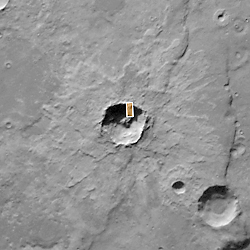
Gullies eroded into the wall of a meteor impact crater in Noachis Terra. This high resolution view (top left) from the Mars Global Surveyor (MGS) Mars Orbiter Camera (MOC) shows channels and associated aprons of debris that are interpreted to have formed by groundwater seepage, surface runoff, and debris flow. The lack of small craters superimposed on the channels and apron deposits indicates that these features are geologically young. It is possible that these gullies indicate that liquid water is present within the martian subsurface today.
The MOC image was acquired on September 28, 1999. The scene covers an area approximately 3 kilometers (1.9 miles) wide by 6.7 km (4.1 mi) high (note, the aspect ratio is 1.5 to 1.0). Sunlight illuminates this area from the upper left. The image is located near 54.8°S, 342.5°W. The context image (above) shows the location of the MOC image on the south-facing wall of an impact crater approximately 20 kilometers (12 miles) in diameter. The context picture was obtained by the Viking 1 orbiter in 1980 and is illuminated from the upper left. The large mound on the floor of the crater in the context view is a sand dune field. The Mars Orbiter Camera high resolution images are taken black-and-white (grayscale); the color seen here has been synthesized from the colors of Mars observed by the MOC wide angle cameras and by the Viking Orbiters in the late 1970s.
A brief description of how the color was generated:The MOC narrow angle camera only takes grayscale (black and white) pictures. To create the color versions seen here, we have taken much lower resolution red and blue images acquired by the MOC's wide angle cameras, and by the Viking Orbiter cameras in the 1970s, synthesized a green image by averaging red and blue, and created a pallette of colors that represent the range of colors on Mars. We then use a relationship that correlates color and brightness to assign a color to each gray level. This only a crude approximation of martian color and should only be considered representative of Mars. It is likely Mars would not look like this to a human observer at Mars.

